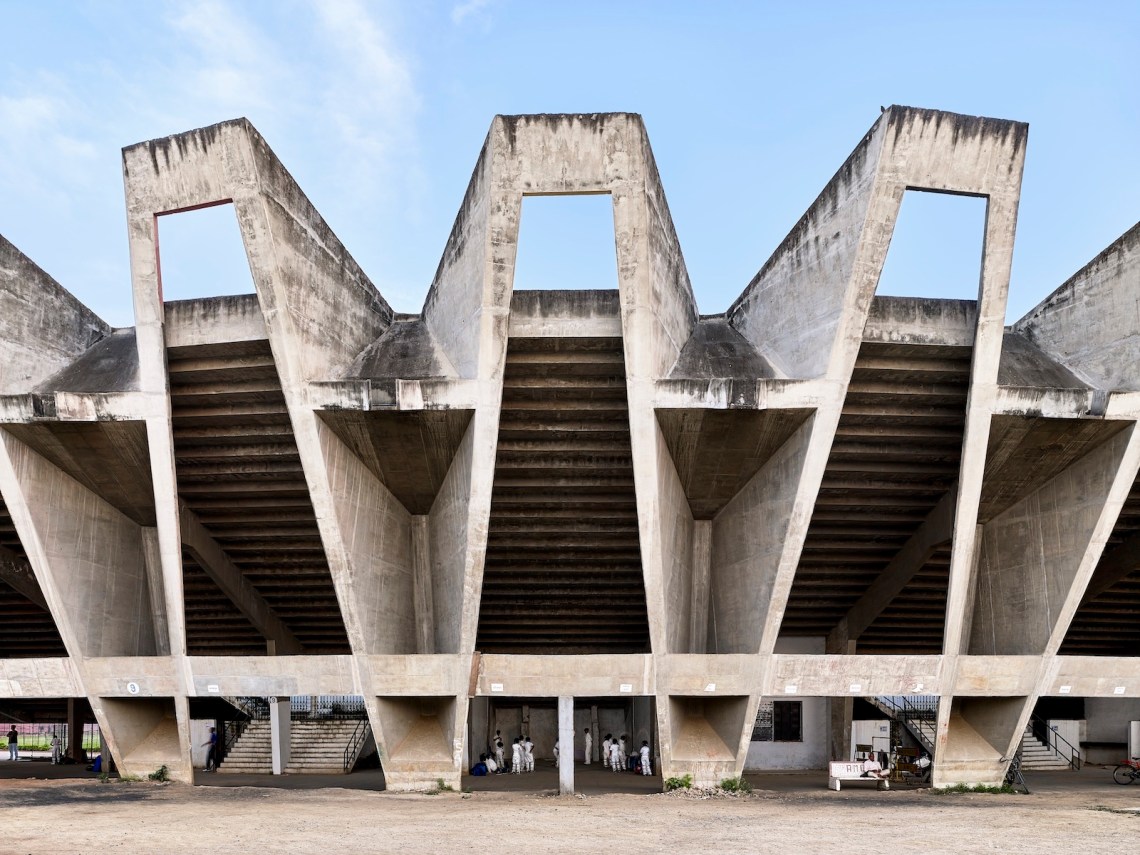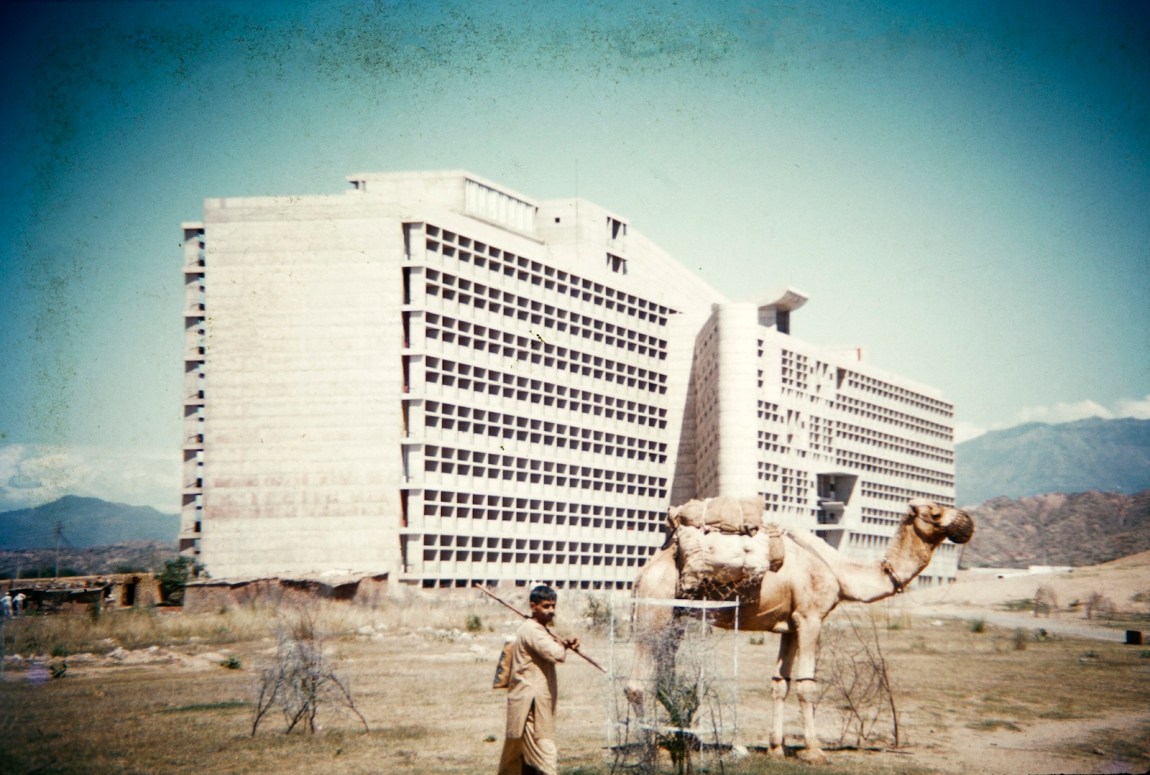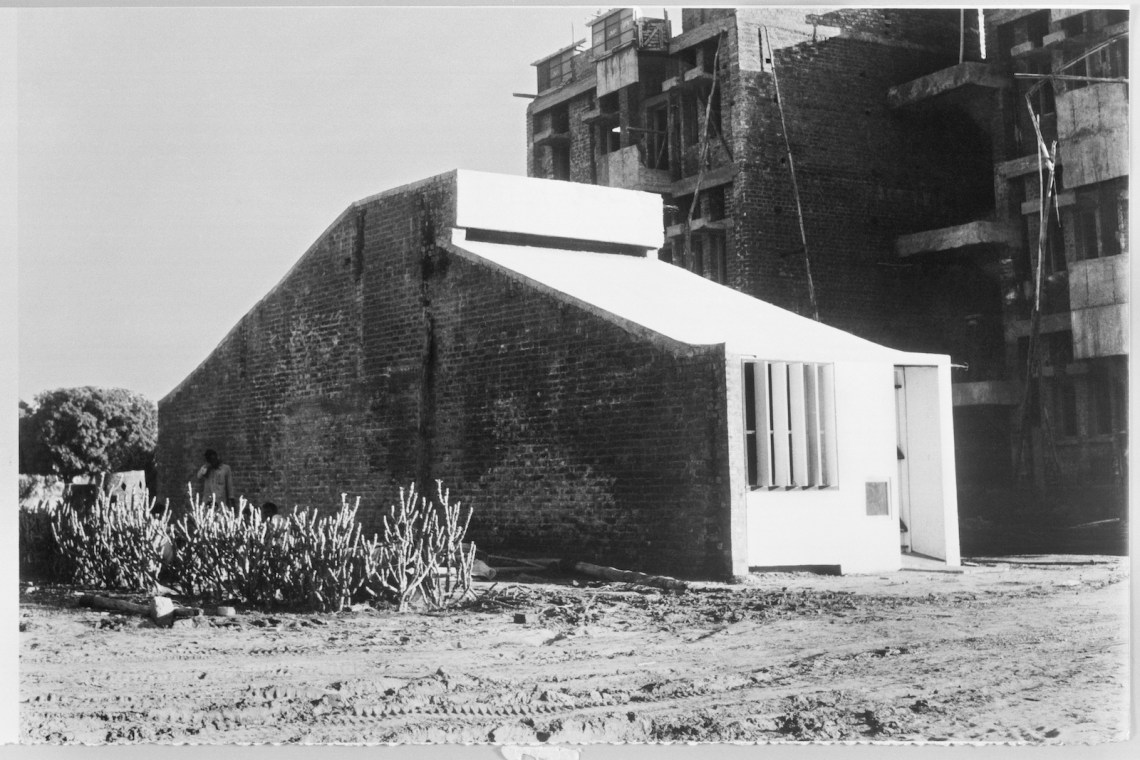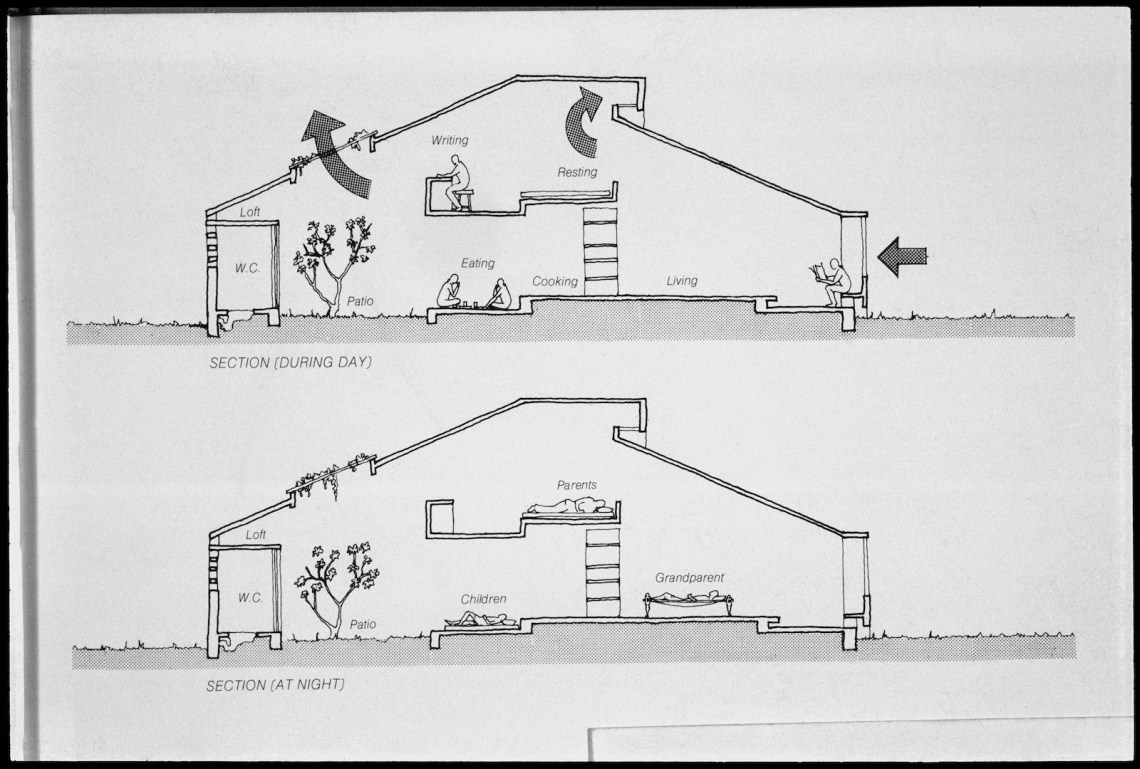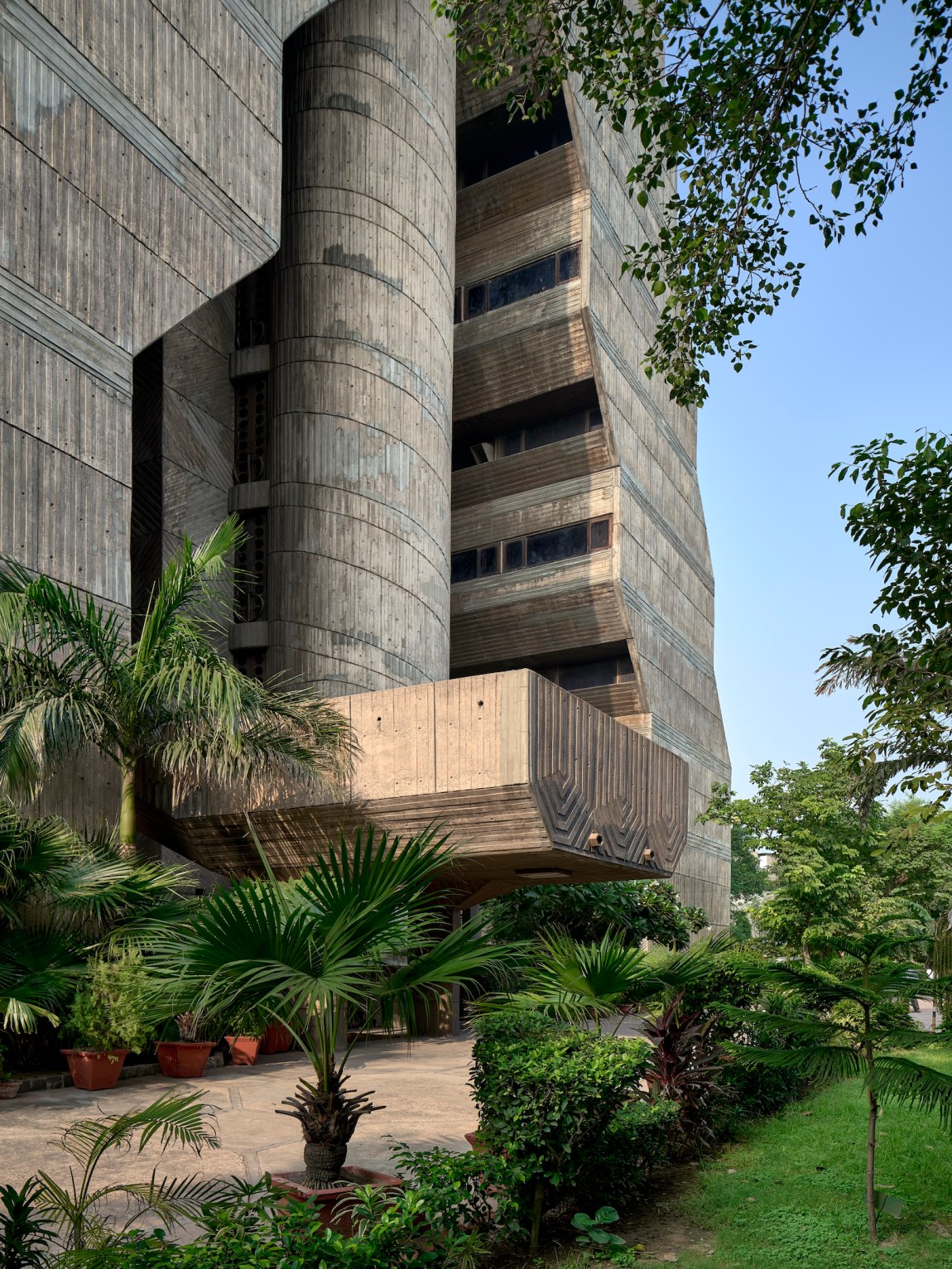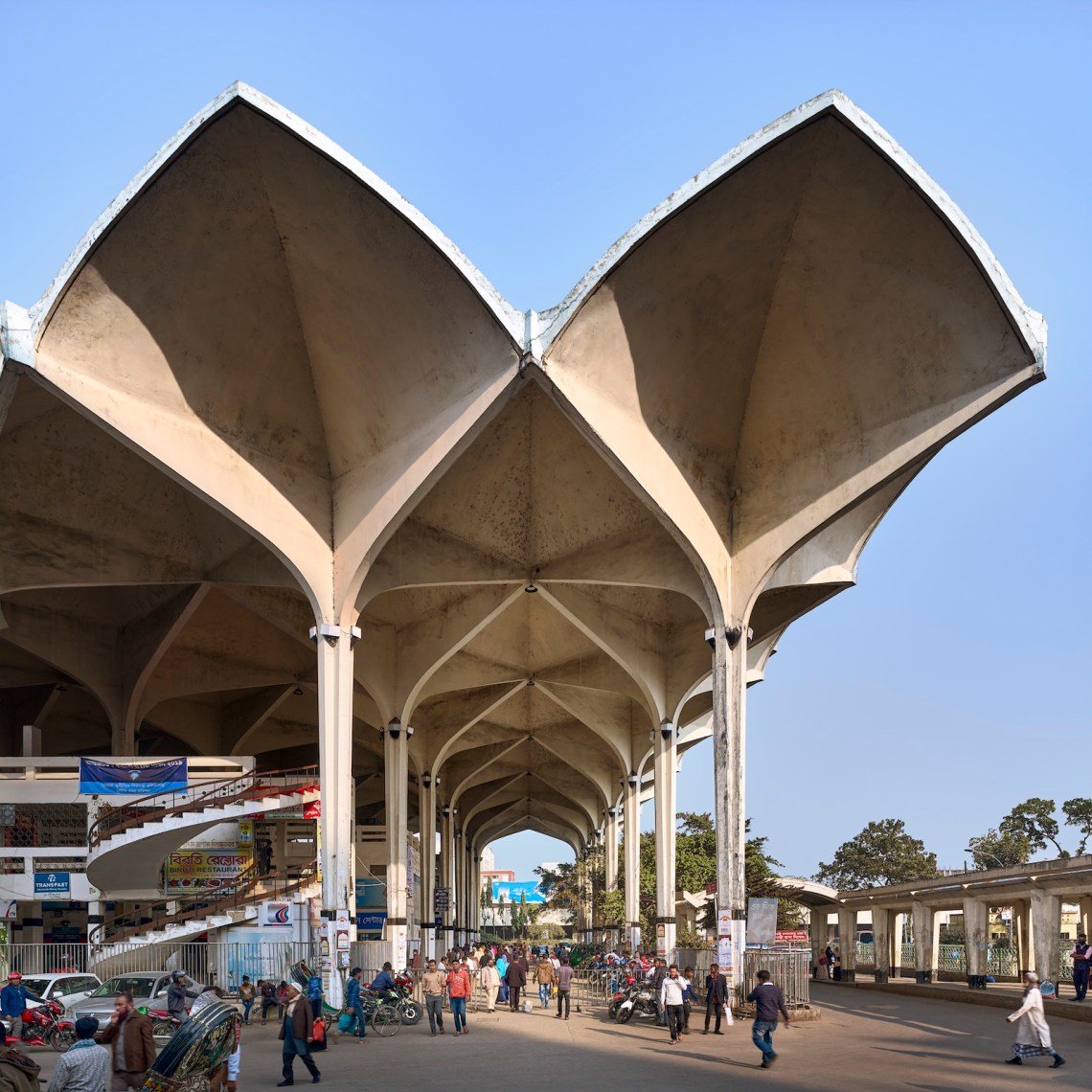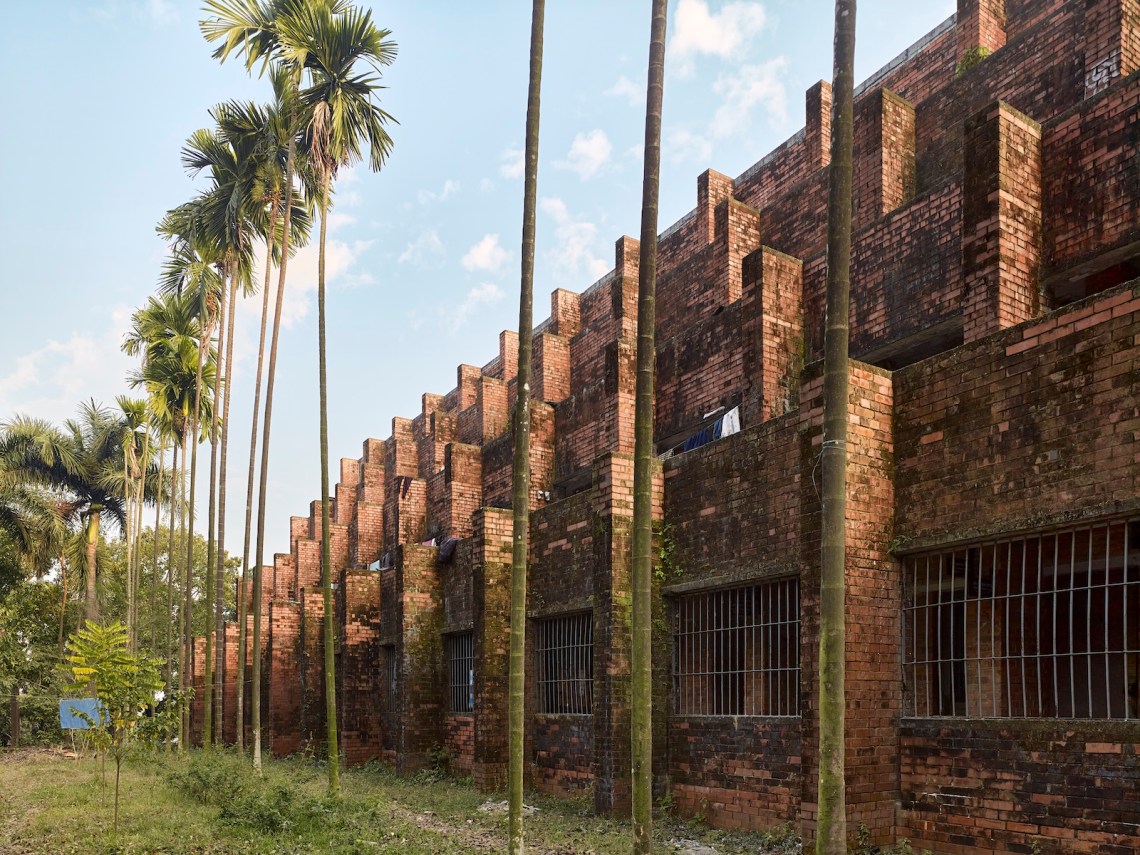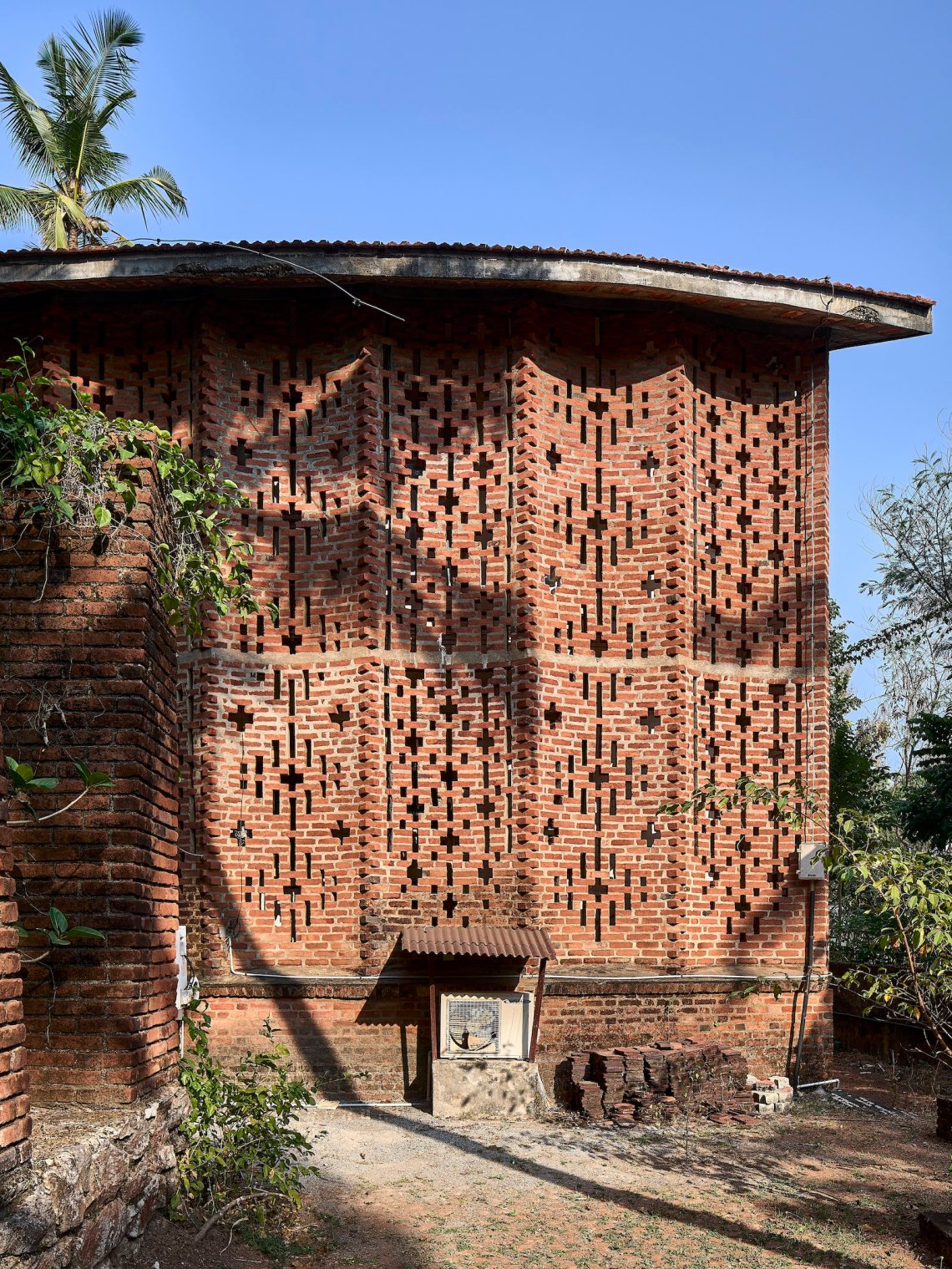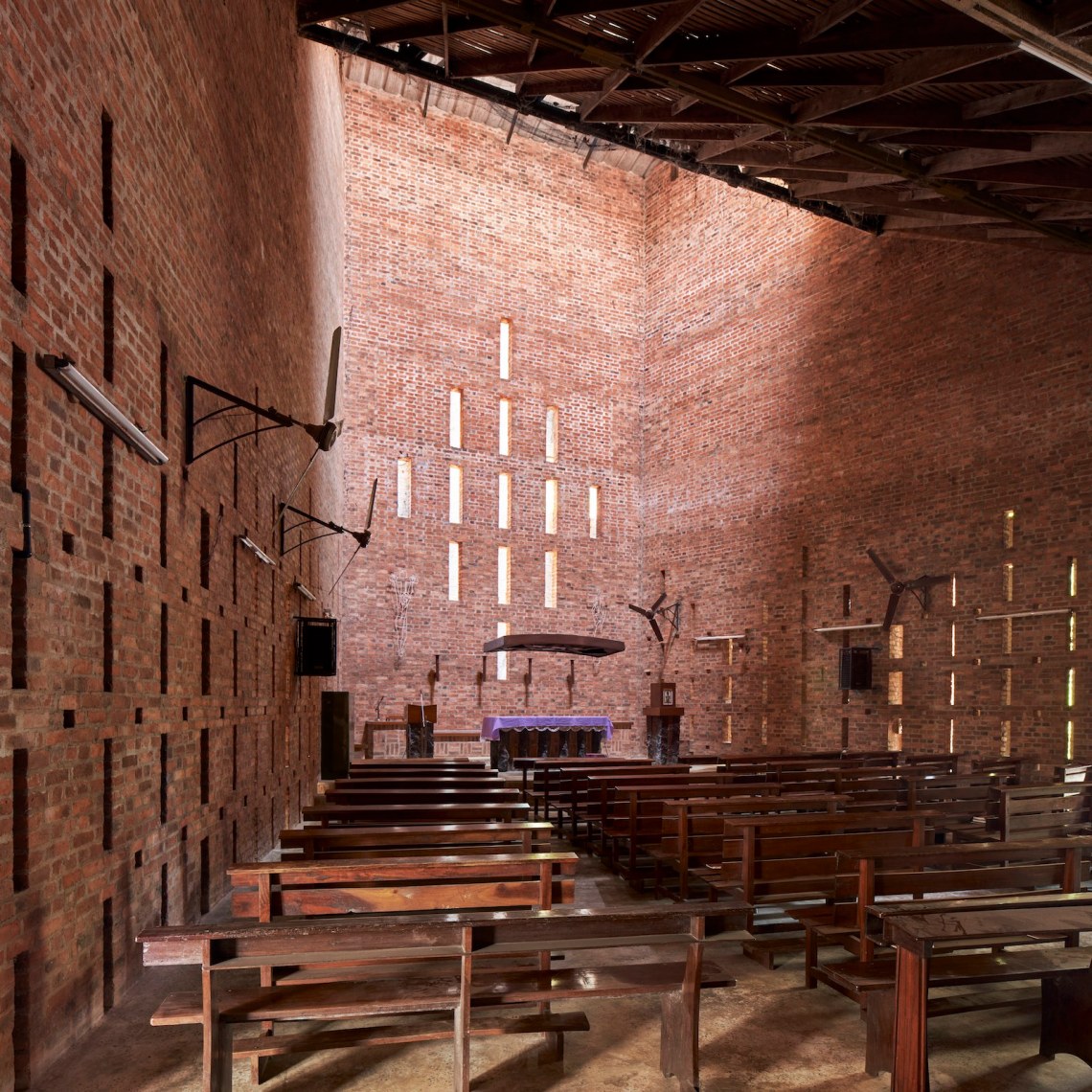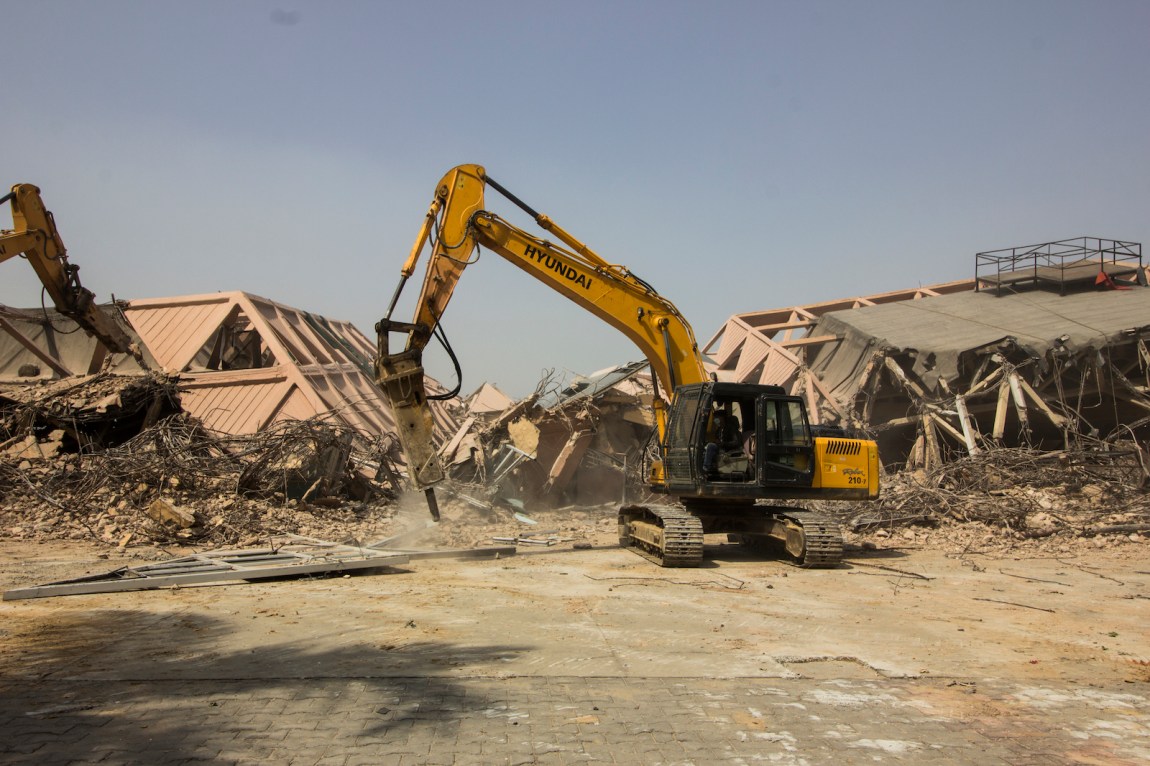Visitors to “The Project of Independence” at the Museum of Modern Art are greeted on their right by seven shadowy faces in a Margaret Bourke-White photograph. They belong, according to the picture’s original caption in Life, to “spindly but determined” Sikh refugees from Pakistan, forced to relocate to a newly independent India after Partition. Their placement in the exhibit suggests they are headed in the direction of the city displayed on the left wall: Chandigarh, the capital of the new Indian state of Punjab, dreamed up by the Swiss-French architect Le Corbusier and his patron, Prime Minister Jawaharlal Nehru.
At the time Bourke-White’s photograph was taken, Chandigarh was still about to rise from the foothills of the Himalayas. Clips from Alain Tanner and John Berger’s 1966 documentary Une Ville à Chandigarh detail its construction, women and men passing rocks and concrete from person to person without the help of so much as a set of wheels. The sickle-shaped roof of the completed Legislative Assembly lies in the background, between the distant Himalayas and the bare earth where the workers trudge. The capitol complex was built in the modernist style imported by Le Corbusier: raw concrete, right angles, generous arcs, and small, purposeful blooms of color. In fact, Le Corbusier designed the whole city according to his conception of formalism, in which neighborhoods were segregated and arranged by social purpose: the government buildings were the “head,” the commercial center the “heart,” and educational and leisure operations the “arms.” By the 1950s modernism was expanding under the banner of democratizing architecture. It would erase the distinction between craft and art, and therefore between craftsman and artist, and demolish the vaunted symbols of the oppressive old regime.
“Brave new Chandigarh, born in the harsh plains of the Punjab without umbilical cord,” wrote the Indian architect Charles Correa a decade later. Nehru had hoped the city would usher India past the human ruin of Partition and prove that the new country was headed forward, toward a technocracy fluent in the international language of modernism and capable of achieving utopia. Instead, Chandigarh was doomed to a state of incompletion, as the reality of the new India overtook Nehru’s dream. One architect after another died, and the city was overwhelmed by twice the number of refugees and migrants it had been planned for—not all of whom found Le Corbusier’s schematic particularly useful or democratic in practice. (Chandigarh’s planners are infamous for forgetting to create housing for the migrant laborers who built the city.)
The MoMA show orients itself around Nehru’s vision of literally reshaping the nation. It tracks the impression made by modernism on the landscapes of Pakistan, Bangladesh, and Sri Lanka, as well as India, from independence, in 1947–1948, to 1985. Within the space of two rooms, “The Project of Independence” aims to cover the cities built from scratch—including Chandigarh, Islamabad, and Auroville—in these new countries; the responses of urban planners to the subcontinent’s expanding housing crisis; the architecture of infrastructure and industry (including tourism); political and civic spaces; schools and universities; and other institutions, including a bank, a mosque, and a planetarium. In the accompanying catalog, the curators delve further into Nehru’s hope that radical architecture would enable and reflect a new Indian society, where ethnic pluralism would grease the wheels of technocratic governance.
Nehru’s political party, the Indian National Congress (usually known simply as “Congress”), was headed by people much like himself: urban liberals, quite likely Hindu, upper-caste, and educated in the West, with nominal commitments to socialism and multiculturalism. (Nehru attended Harrow, where his friends called him “Joe”; Cambridge; and the London School of Economics.) In contrast to Mahatma Gandhi’s idealized village life, Nehru imagined an India that could square up to the West on its terms, built around industrial manufacturing and urban life. Gandhi took the autonomous village as the basis for his belief that self-reliance was a precondition for self-rule. For Nehru, this small-scale self-sufficiency was incompatible with the industrial efficiency required for true economic independence; the cultural values of village life were an obstacle to becoming a modern nation. But, as in the West, the transition to urban life helped lead to a dire housing shortage. Though the primary cause of the subcontinent-wide housing crisis was the global midcentury population boom, Nehru’s attempts to move the economic center of gravity away from rural farms and toward cities certainly contributed to it. A 1954 state-sponsored documentary on view at MoMA explores the issue: “So acute is the problem now that many of us are forced to live in slums,” says the narrator in BBC English.
One solution was to build new cities from the ground up; another was to commission low-cost designs for homes that could be built by residents themselves. Correa’s Tube House was one such plan: a single-family one-room windcatcher house, with a mezzanine that allowed for a tiny footprint and natural air circulation. Correa, the preeminent Indian architect of the time, also headed a team that proposed a “New Bombay” plan to expand that overflowing city. As the architect Rahul Mehrotra notes in the MoMA catalog, it was his “low-rise, high-density paradigm that led to a significant shift in the Indian state’s reimagination of housing design.” Nevertheless, state capacity was more willingly directed to clearing slums than providing housing, especially with architecturally adventurous designs. By the 1970s, many architects, Correa included, were turning to private practice to experiment with alternative housing forms.
Advertisement
The curators of “The Project of Independence,” Martino Stierli, Anoma Pieris, Sean Anderson, and Evangelos Kotsioris, are explicit in their efforts to balance the show among the four nations. In the catalog, Stierli and Pieris write that “other countries that are commonly considered to be part of the region, such as Afghanistan, Bhutan, Maldives, and Nepal, have different political histories and diverging cultural trajectories, and are for this reason not included,” though Louis Kahn’s 1974 Family Planning Center in Kathmandu also falls at the intersection of architectural experimentation, statecraft, and later neglect explored in the show. But in the small space allotted, it’s hard for India not to loom large. Even at the moment of independence, India was more populous than the rest of the subcontinent combined; it had much more economic power and global ambition than Sri Lanka, and the turbulent political trajectories of Pakistan and Bangladesh, which won independence from Pakistan in 1971, waylaid the post-independence statist plans in those countries. Nehru’s prolific recruitment of architects, his grand vision for the future, his powerful rhetoric of democratic idealism and secular multiculturalism, and the contrast he strikes with contemporary Indian proto-fascism make him a tempting focus for the exhibition.
*
Nehru’s version of nationalism was inseparable from cosmopolitanism. He hoped India would one day again be a magnet for people from all over the world, and he refused to accommodate lingering colonial resentment. In his best-selling books about subaltern history, written from inside British prison cells in the decades before independence, he projected absolute confidence in the past and future of South Asia. From the moment the new flag was raised, the rupture with a European past was a fait accompli, not a source of anxiety or defiance, and he had no qualms about inviting Western architects to redesign his country. (At least the continental and American planners would improve over the British ones, whose fussy symmetries still linger in Delhi.)
Nehru had hoped architects would come to India in a spirit of experimentation and treat the country as a blank slate on which the most audacious and forward-thinking constructions in the world might be made. The foreign architects who made the trip—among them Louis Kahn and Charles and Ray Eames, as well as Richard Neutra and Constantinos Doxiadis in Pakistan and Ulrik Plesner in Sri Lanka—were curious and eager to research, consulting and corresponding with their South Asian colleagues. Le Corbusier wrote often to Nehru asking for his thoughts on Indian architectural traditions and suggestions for motifs to include in Chandigarh; Nehru responded that he wasn’t an expert, and Le Corbusier should figure it out himself.
These Western architects often worked as partners or mentors to architects from the subcontinent, many of whom had already studied abroad. Besides Correa, Balkrishna Doshi, Achyut Kanvinde, Raj Rewal, Muzharul Islam, Habib Rahman, and other more well-known names, the MoMA curators make a point of introducing the work of female architects, including the ecologically minded Sri Lankan architect Minnette de Silva and the Pakistani Yasmeen Lari, whose low-income housing projects enlisted residents as laborers to construct and adapt their own homes.
The question that followed these native architects was whether the International Style of Le Corbusier and Walter Gropius was flattening and inflexible or multifaceted, accommodating, and capable of syncretism. Constraints of climate, labor, and material foreclosed the possibility of construction in an unmodified International Style, but people like Rahman tried to import as many of the principles of structural rationality as possible from their studies abroad. His 1954 steel-frame New Secretariat Building in Calcutta was the tallest Indian office building of its time, and except for one brick section—from which the Indian flag flies—might have been airlifted from Miami. The brick was evidently not concession enough; in the decades since, it has been repainted from its original sandy neutral to a bright blue.
Advertisement
Subcontinental architects recognized, in their Bauhaus education, a solution to a problem that mirrored their own. Both streams of architecture had utopian ambitions, hoping to tear away decisively from an old world whose fractures were impossible to mend. In the colonial period, urban planners had tried to coat European ideas about grandeur, order, and hygiene in a veneer of native tradition. The widespread colonial use of “Indo-Saracenic” motifs, drawing on the icons of Mughal and South Indian architecture, had denatured them of their splendor and changed their connotations for the layperson. If architects wanted to make independence manifest, they would have to look beyond the recent past for inspiration.
The post-independence politicians and architects ran into the same problem as the curators of the MoMA show: how to cohere the vastly different peoples of these new nations? The curators argue that the subjects of the exhibition drew on vernacular forms such as the communal rooftop—a shared space connecting multiple units in the same building, used especially by women to hang laundry and socialize—to integrate the civic ideals of the new states with the aesthetic values of modernism. But the modernist dogma of progress could only conceive of a single trajectory—the Western European trajectory—from feudalism to capitalism and eventually some form of social democracy, with industrial development as the bedrock of the economy and society. Architects returned from their studies at Harvard and Yale to India, Pakistan, and Sri Lanka believing they were vanguards bringing the future to a society underdeveloped by colonialism.
In many cases, foreign architects had no choice but to adapt European customs to local ones. Architects would discover at the building site that the materials they had planned to use, or the type of skilled labor required to apply them, were unavailable, and would have to make do with brick or in-situ concrete casting. But given their choice of materials, modernists both foreign and local would always prefer prefab roofs over palmyra thatch and concrete floors over cow dung.
This was less a Western preference than an urban one. Many of the curators’ examples of regional architecture adapted to modernist use are from the great cities of the subcontinent, not the villages where the vast majority of the region’s population lived. Local traditions were represented in designs for more transient objects, like Pierre Jeanneret’s Chandigarh cane chairs or Barbara Sansoni’s textile patterns for Sri Lankan sarongs: the kind of handicrafts that students at Gita and Gautam Sarabhai’s design school in Ahmedabad studied and tried to industrialize. Someone visiting the MoMA show might walk away with a sense of South Asian vernacular architecture as basically the use of courtyards and latticed jali walls, which provide ornament, light, and breeze. But courtyards and brick latticework are found everywhere from Guangzhou to Casablanca, and the everyday architectures of South Asia are as varied as its population.
The MoMA show emphasizes the humanistic aspect of Brutalism. But Brutalism, always controversial with the public, arrived on particularly hostile shores in South Asia, where the connotation of raw concrete is not the factory but the slum. In structures like Balkrishna Doshi’s Premabhai Hall, it proved an awkward material for epitomizing the nascent state and its capitalist aspirations. Unfinished concrete buildings next to plastered facades might reflect honesty about labor in an industrial society; beautiful Brutalist architecture side-by-side with half-built tenements seems more like deliberate self-deception, an illogical aspiration to replace the memory of a hovel with a factory without ever removing the conditions in which slums emerge.
The British-born Laurie Baker was perhaps the most radical of the architects represented in the exhibition. He was one of few foreigners who ended up staying in the subcontinent, and his meditative brick chapel in Trivandrum is one of only two religious structures featured in the exhibition (the other is Anwar Said’s mosque in Islamabad). Baker published a series of polemical pamphlets that followed a more Gandhian vision of architecture, advocating for the self-reliance of ordinary people. Any local craftspeople might use their existing knowledge to implement his plans, included in the pamphlets, for adaptive low-cost housing made of bricks, lime, and waste material. Ink sketches illustrate his belief that concrete, the medium of Nehruvian industrial aspiration, was an expensive, fuel-intensive, technically unwieldy, and overall impractical way to build a new India.
Baker was one of the few architects of this period who considered rural life much more than an embarrassing stage from which to emerge. And yet, as Nehruvian developmentalism failed to transition India’s economy from agriculture to manufacturing, most Indians continued to live outside cities. India’s path to becoming a major world economy did not involve mass industrialization, though Congress’s policies of condescension and neglect toward the rural poor did ensure that they largely remain in poverty to this day, with limited access to the infrastructure—education, health care, water, power, roads—that was so important to the growing urban bourgeoisie.
*
In the 1980s the architecture of the subcontinent made a “regionalist turn,” the genesis of which is visible even in the exhibition’s focus on modernist universalism. Architects like Correa, who had helped bring European modernism to India, and Geoffrey Bawa, who had been its devoted students, began to prefer stone façades and tiled roofs. As neoliberal governments took power, import-substitution policies ended, and international financial institutions began to once again dictate the terms of the economy (as in the case of the International Monetary Fund’s structural adjustment programs in Sri Lanka), state funding dried up and architects turned to smaller projects for private clients.
The art and architecture magazine Marg had been an important forum for designers and critics across the subcontinent and the wider world since its inception in 1946. Its distinction was contested by Mimar, the magazine of the well-funded Aga Khan Prize established in 1977 that encouraged architects to pursue more regionally distinct projects. Architects had to choose between two standpoints which had previously been in dialogue, as Anoma Pieris writes in the catalog: “one informed by the indigenous identities that made their voices authentic and the other by Western education that legitimized them and often led them to modify their design vocabulary to gain international recognition.” They no longer had to represent the state or the people, only themselves.
One external force pushing toward regionalism was the increasing military tensions of the 1970s and 1980s, which saw the outbreak of civil war in Sri Lanka, the Emergency in India, and military dictatorships in Pakistan and Bangladesh. The often-racialized violence that began in this moment continued and expanded, in one form or another, through the present day. In an inversion of the earlier belief that colonialism had impeded the advent of industrial, cosmopolitan modernity in South Asia, the newly empowered right believed that colonialism and modernity were coterminous; rejecting the former could only be accomplished by rejecting the latter in favor of an ethnically essentialized past.
For all of Nehru’s efforts, India’s most significant architectural event in the past seventy-five years was the destruction of the Babri Masjid, on the shaky grounds that it had been built over a Hindu temple. The curators end their survey seven years before the sixteenth-century mosque’s illegal demolition by a mob of Hindu nationalists, and it’s a wise choice: though the exhibition elides the incipient Hindu chauvinism of those decades, it’s a reminder that such violence was not inevitable. The stormers of the mosque claimed to be representing ancient history, but they were really refuting the more immediate past the exhibition embraces, when a pluralistic India, if it had yet to be fully realized, was within closer reach than it is today.
As Kai Friese noted recently, scale has become the sole aspiration of Modi’s Bharatiya Janata Party architecture. Temples are built on the order of stadia and statues are constructed to rival mountains (and minarets). The MoMA show features few buildings that are truly monumental in size or purpose—there are only fleeting mentions of Louis Kahn’s transfixing parliament in Dhaka or Habib Rahman’s compact Calcutta memorial to Gandhi. Chandigarh’s sweeping buildings are the closest comparison to the muscling grandeur and symbolic overflow of contemporary architecture, yet they remain worlds apart. Raj Rewal and Mahendra Raj’s 1972 Hall of Nations exhibition pavilion, an enormous yet astonishingly delicate tessellation of free-span concrete triangles, was demolished overnight in 2017.
In the catalog, Mrinalini Rajagopalan writes that the Hall of Nations was one domino in a larger chain of strategic demolition: “Nationalist impulses in the region have targeted modern architecture and its idealization of secular principles and rationality over ethnic and religious identities.” The taste of the region now is for spectacle and identitarian kitsch, and the multicultural ideals of the past are associated with the economic failures of those governments.
What might an architecturally pluralist South Asia look like? The curators never show us, only lamenting the loss of democratic ideals that had supposedly been manifested in modernism’s universality. (Never mind Nehru’s own concessions to the Hindu right or the lengths he went to deny Kashmir self-determination.) The curators’ only metric of failure is demolition; what about the failure of the ideas behind the buildings, including the notion that the government could generate and distribute shared civic values from the top down? The gorgeous collection of plans, models, and historical footage in the MoMA show evokes a powerful sense of the post-independence years as full of possibility, and we are left to assume that the right arrangement of units within a housing complex might bring about ethnic harmony or economic mobility. These beautiful buildings might stand as monuments of a more open past, but preserving them won’t bring it back.


